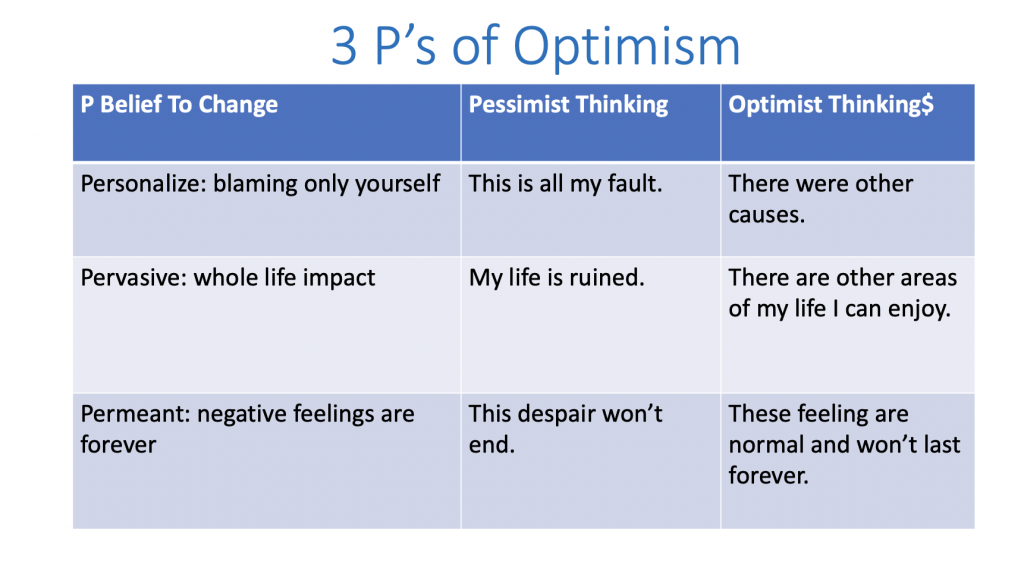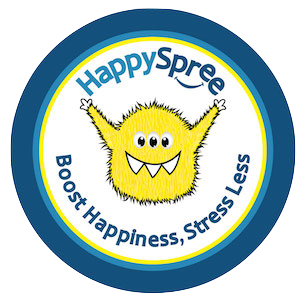We are what we think. So after a breakup, thinking “my life is awful”, “it’s all my fault”, and “this agony will never end and I’ll die alone and my cat will eat me” results in negative feelings. Luckily it’s possible to use learned optimism to change thinking patterns and feel better fast.
Psychologist and happiness expert Dr. Martin Seligman discovered that positive thinking patterns can increase healing and recovery from adversity, and they also increase well-being and happiness. Seligman recommends using the Three P’s of Learned Optimism: (1) Personalization, (2) Pervasiveness, and (3) Permanence to gain perspective when you’re feeling bad. This learned optimism changes pessimistic thinking patterns to positive and this gets easier with practice.
But why bother thinking positive when negative things keep happening? Seligman reports that pessimists get depressed more easily, underperform at work, school, and sports, have less stable relationships, and experience worse health than optimists. In contrast, optimists succeed better at school, work, and leisure activities. They have more robust social networks, experience better health and may live longer. Bad things happen to everyone and choosing how to react changes how we feel. Use the 3 P’s to change thinking patterns from negative to positive.

After a breakup, start by examining personalization. Your breakup isn’t 100% your fault, so think of other contributing factors that may have contributed. Maybe your ex’s mother didn’t like your cat, maybe job challenges stressed your relationship, or maybe single friends tempted your ex to play too often. So, maybe you could change “this is entirely my fault” to “job stress made my ex grouchy and that didn’t help our relationship”. Understanding personalization leads to optimistic thinking and this reduces blame and self-criticism.
Next, consider pervasiveness, which means understanding that not all areas of your life are affected by your breakup. Breakups are difficult but focusing on non-romantic activities or relationships can make you feel better. For instance, choose a flow activity, like learning how to play a musical instrument, writing or painting; or volunteer, or grow friend or family relationships, these activities are proven to increase happiness according to Seligman’s research. Also, your dog or a friend’s dog will always love you no matter what.
Finally, permanence means realizing that intense breakup pain is temporary. Breakups can follow the grief stages discovered by psychiatrist Elizabeth Kubler-Ross: denial, anger, bargaining, depression, and acceptance. You may move up and down through the grief stages, or not experience all of them. You will feel better with time as you process your emotions and move towards acceptance. For now, remember that intense pain isn’t permanent. So if you tell yourself “My life is awful, will always be awful and I’m going to die alone and my cat will eat me” or “I’m going crazy” you’ll feel worse. Instead, thinking “I’ll feel better with time” or “feeling sad after a breakup is normal” can help you feel better.
Recovery Is Possible After Intense Grief
In her book Option B: Facing Adversity, Building Resilience and Finding Joy, Cheryl Sandberg, Facebook COO, applied the three P’s to her life after her husband’s sudden death from a heart attack. Upon reflection, Sandberg realized that her husband’s death was not her fault, some areas of her life weren’t terrible (for instance, birthday parties with her kids), and her crushing grief wouldn’t last forever.
Sandberg’s painfully honest self-reflection inspired me to use the three P’s to recover after my divorce. I needed help stopping PTSD-like symptoms caused by ruminating about what I did wrong during my marriage and also whenever I saw my ex-husband, which was necessary during my kids’ soccer and lacrosse games. I knew my rapid heartbeat, sweating, and difficulty breathing were harmful to me but I couldn’t stop negative thoughts.
When thinking through the three P lens, I realized my divorce wasn’t wholly my fault. For instance, my ex-husband’s challenges were not in my control, I hadn’t caused them, and couldn’t fix them. Further, I realized that distress from my divorce no longer impacts most of my life, and the pain from my marriage is decreasing every day.
As my guilt and self-blame lessened I felt better about my self and my future. Also, I noticed the Three P’s had calmed my stress response. For the first time when thinking about my breakup, my breathing and heartbeat felt normal, and I wasn’t sweating. A deep sense of relief and gratitude towards Dr. Seligman and his research swelled in my heart.
Optimistic thinking also helps adolescents. In one study, participants ages 10-15, with low to moderate hopelessness, utilized cognitive behavioral therapy, including the three P’s, to improve depression, anxiety, hopelessness, and coping (Gillham et al., 2012). I could identify with the study participants, as I had experienced hopelessness while married. Indeed, the three P’s can help us gain insight leading to success both at school and at home.
Also, this knowledge helps defeat passivity, which is the default response to shock caused by adversity, and we must work to overcome this to increase wellbeing. Learning how to control thoughts and behaviors can overcome passivity.
The three P’s are a powerful thought tool we can apply to all areas in our lives. So, like Sandberg’s recovery after her husband’s death, the students overcoming hopelessness, and me changing negative thinking to positive, the three P’s increased my happiness and well-being. I hope you’ll use them to do the same for you.
Want more happiness and to track your happiness trends? Join HappySpree



